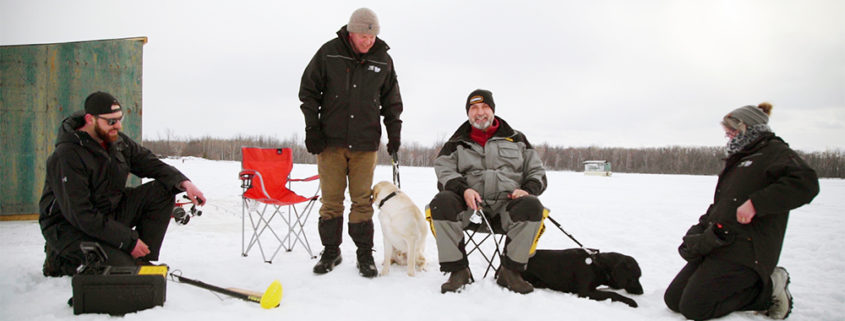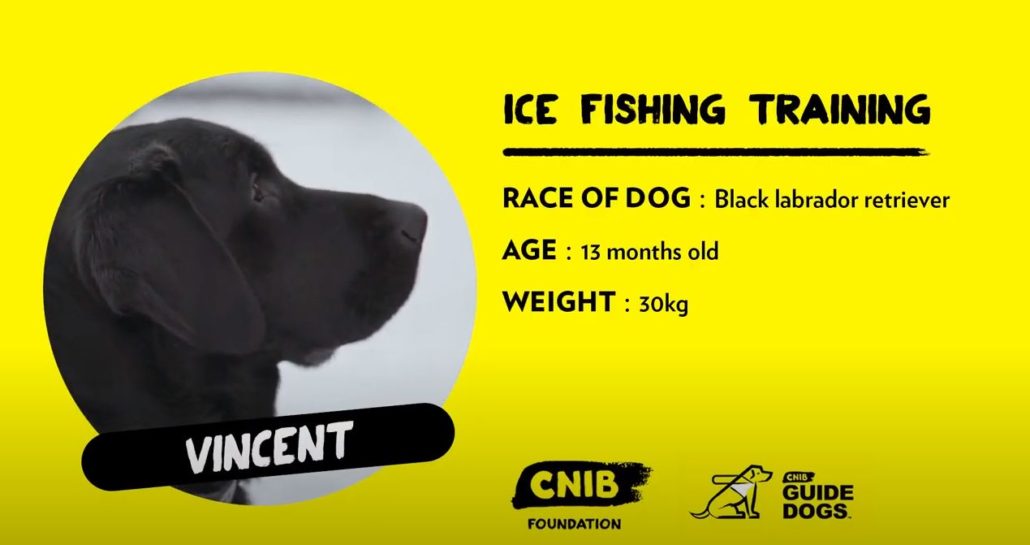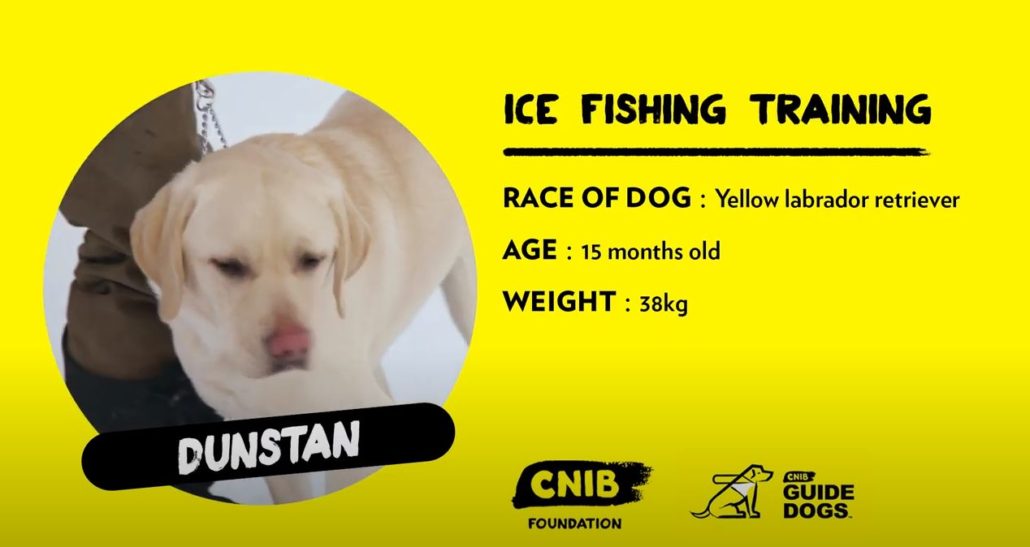Episode 4: Cross-Country Skiing and Ice Fishing – Part 2: Ice Fishing
Getting outdoors in the winter is the best way to make it through this dark and cold season and stay healthy. Keeping indoors means missing out on important exercise, fresh air, and vitamin D. But ice fishing, really? That’s what most people ask, or just assume it’s really an activity that is more about drinking.
Yes, there are some who ice fish solely for let’s just say “social” reasons, and I get that. But I’m more goal oriented – I want a challenge. In this case, it really is about finding and catching fish through the ice. And ’m not alone. There are plenty who gear up for a season of ice fishing and who look forward to that time when the ice thickness is sufficient to safely venture out on it.
Joining us for this outdoor activity were Karen and Andrew Hanlon. They brought along two CNIB guide dog trainees, Dunstan and Vincent. Also coming along for the fun were my wife, Anne, and our kids, Theo and Lilly. We all met up beside of the frozen Ottawa River, just outside city limits. My fishing buddy, Jason Cox, had a hand-made wooden ice shelter that we would be using as our base, and I provided the snowmobile.
While Jason used the snowmobile to relay the anglers and gear out on to the ice, Karen, Andrew, and I walked out with the two dogs. Our goal for the day was to introduce the dogs to noisy things like snowmobiles and gas-powered ice augers, and dangerous holes in the ice and the frozen lunar landscape of a river in the Canadian winter. Dogs love this last part. Being out on a frozen lake or river means you can see for miles in all directions. There’s almost nothing to block your vision, other than possibly ice shacks. Unless you live on the prairies, there is little that can compare.
Being out on a frozen lake or river also means wind and cold can be an issue. Having sufficient layers and a way to get out of the cold and warm up is highly recommended. You don’t need to stay all day inside ice shack fishing, but it’s there if you need it. Personally, unless it’s an unseasonably warm winter day, like the ones we usually get later in March, I usually do my fishing inside a shack, or one of my temporary transportable flip-over or pop-up tent style ice fishing shelters.
I fish using touch. Others simply watch the tip of their ice fishing rod for movement to alert them to a bite from a fish below, but since that’s not going to work for me, I like to hold my ice fishing rod with directly with my hand so I can feel the bite.
There are devices that can making ice fishing an audible event. You can add a small bell to the tip of your rod, or a BlueTipz wireless device that sends a Bluetooth signal to your smartphone when a bite occurs. There are other technologies I’ve integrated into this activity, but I think you get the drift.
One of the tests we conducted with the two dogs was to have Jason drive by slowly with the snowmobile. Each time he passed by, he came closer and closer. Neither of the dogs seemed to mind.
Another test involved drilling holes in the ice with a gas-powered auger. I have manual augers and have experimented with electric options, but when the ice gets over a half-meter thick, using a gas-powered auger is the only practical way to get the job done. I had just finished drilling the first hole and had pulled out the auger from the hole when Vincent sprang forward and took a good look down the hole I had just bored. He certainly is a curious dog. He also kept close watch on the drone that we were using to film.
Dunstan was more interested in looking around on top of the ice and noting what other dogs were up to. He was his usual chill self. He was for sure the least likely to get into trouble. I could tell Vincent was interested in taking a good long run to visit the other ice fishers and their dogs, or catching something, whether from under the ice or flying above. He seems to have a bit of a hunter instinct, which I’m O.K with. I kind of like Vincent, but you can’t beat Dunstan’s composure under pressure either. I’m torn…
We only had a half day, so by the time we had got ourselves situated on the ice and the camera and sound equipment rolling, and then the tests of the dogs, it didn’t give us a lot of time for fishing. But that’s O.K. since actually catching a fish was way down on our list of priorities.
We managed to fish for an hour, but I don’t think any of us were taking that part of the day serious enough to really catch a fish. It was a success though, just like non-winter fishing, it’s better than sitting in doors. And the dogs did great too.
Here’s a couple safety tips: Never ice fish alone, it can make timely rescue impossible. Always check the thickness of the ice before and during your movement on the frozen water. Keep ice picks handy just in case you break through. These clever little devices make the difference between being able to pull yourself out or becoming a frozen bump on the ice. And, always let people know where you are going and when to expect you back.
And now for dog safety: Always bring a blanket for the dog to curl up on should they get cold or wet. Make sure your ice cleats on the bottom of your boots aren’t the type that could cause injury to a dog’s paw if stepped on. Keep your dog on a leash until you are certain you are well clear of any thin ice or open water. If a risk exists, which they often due, then make sure you keep your dog away from the hazard as they have no idea about thin ice or the challenge of climbing back out on to hard ice. Get your dog a good winter jacket to help them maintain core body temperature.
Remember, guide dogs spend most of their lives indoors and this means they never properly develop winter coats. Use paw protection if the ice is not covered with a layer of snow. Exposed ice can cut your dog’s paws, and nothing can bring to an end a guide dog’s ability to do their job than a badly cut paw.





